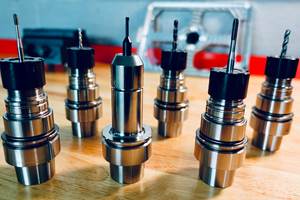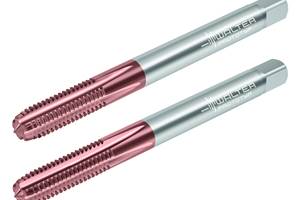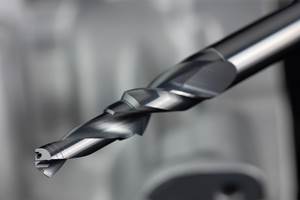Dealing With A Spot Drill’s True Point Position
A spot drill has a 90-degree point angle, which makes it easy to calculate the depth of a hole to be spot-drilled. You simply divide the diameter of the spot-drilled hole.
A spot drill has a 90-degree point angle, which makes it easy to calculate the depth of a hole to be spot-drilled. You simply divide the diameter of the spot-drilled hole. If you have drilled a 0.25" diameter hole and want a 0.031" chamfer on the hole, the diameter to be spot drilled will be 0.312". The spot-drill depth, 0.156" is half of this.
If this is the method you’re using to determine spot-drill depths, you’ve probably noticed that the chamfer on the hole is a bit large. The larger the spot drill, the larger the chamfer. Why is this? It is because the true point has been “ground off” the spot drill during sharpening. While the spot drill does have a 90-degree angle, the point of the tool that you actually touch during tool-length compensation measurement is not the true point of the spot drill. The drawing below illustrates this.
As you can see, the tool tip that is used for tool-length measurement is not the true point of the spot drill. Again, the larger the spot drill, the greater the difference will be. To precisely machine the chamfer to its intended size on the first try, you must deal with this difference.
How do you deal with this problem? I offer two ways, depending on how many programs you’ve already created using the simple formula mentioned above (spot-drill depth is half the chamfer size).
If you already created many programs, you probably won’t want to go back and change them all. You can deal with this problem during tool-length measurement. On the other hand, if have very few programs to deal with, you should deal with the problem in the program. Frankly, you’ll make life easier for setup people and tool setters if your programs include compensated spot-drill depths. This would be my first choice, but I can understand your concern at having to change hundreds of previously created programs. I’ll offer a compromise a little later.
How much do you compensate? Fortunately, the amount of deviation will remain pretty consistent for a given spot-drill size. Here are four spot-drill sizes along with the difference between the true point and the tip of the tool:
0.375" diameter: 0.026" deviation
0.500" diameter: 0.035" deviation
0.750" diameter: 0.045" deviation
1.000" diameter: 0.060" deviation
For example, if you are using a 0.500" diameter spot drill, and your tool setter measures the tool length compensation offset value to the tool tip, the correct depth to machine a 0.312" chamfer will be 0.121" (0.312" divided by 2, minus the 0.035" deviation).
Handling the problem during tool setting. By one means or another, the person determining a spot drill’s tool length compensation value must consider the deviation amount. If measuring the tool’s length, the operator must increase the tool length compensation value by the deviation amount. One way to do this is to simply measure the tool’s length in the usual manner and then add the deviation amount. Another is to provide the tool setter with one shim for each spot drill size that can be used during the tool length measurement. If measuring tool-length compensation values at the machine, similar techniques must be used.
Handling the problem in the program. Again, this is my preferred method because it doesn’t require any intervention for shop people. Obviously, the programmed depth for spot drilled holes must reflect the deviation. This may not be as difficult as it might seem at first because most programmers use canned cycles for spot drilling. It’s likely that only one word per program must be changed (the Z value in the spot drill’s G81 command).
Another way to handle the problem is to use a G10 command to increase the offset value by the deviation amount. This means the tool setter will measure to the tool tip, and your programs need not change. However, the offset changing G10 command must be executed only one time (obviously, it is changing the offset value for the spot drill).
Related Content
How Lowering Torque Improves Tapping Tool Life
Escaping the tap breakage trap requires a long look at torque and the many factors that influence it.
Read MoreKay Engineering's Gundrilling Machine Performs Range of Operations
Kay Engineering’s DeHoff 20144 is used to perform gundrilling, pull boring, roller burnishing and thread tapping.
Read MoreWalter Offers New Solid-Carbide Taps for Blind-Hole Machining
Walter’s TC388 Supreme and TC389 Supreme feature patent-pending cutting geometries that fully shear off the root of the chip when reversing, thus minimizing torque peaks.
Read MoreEmuge-Franken's New Drill Geometry Optimizes Chipbreaking
PunchDrill features patent-pending geometry with a chipbreaker that produces short chips to control machining forces.
Read MoreRead Next
The Cut Scene: The Finer Details of Large-Format Machining
Small details and features can have an outsized impact on large parts, such as Barbco’s collapsible utility drill head.
Read More3 Mistakes That Cause CNC Programs to Fail
Despite enhancements to manufacturing technology, there are still issues today that can cause programs to fail. These failures can cause lost time, scrapped parts, damaged machines and even injured operators.
Read More
.jpg;width=70;height=70;mode=crop)



.png;maxWidth=300;quality=90)










.png;maxWidth=300;quality=90)







